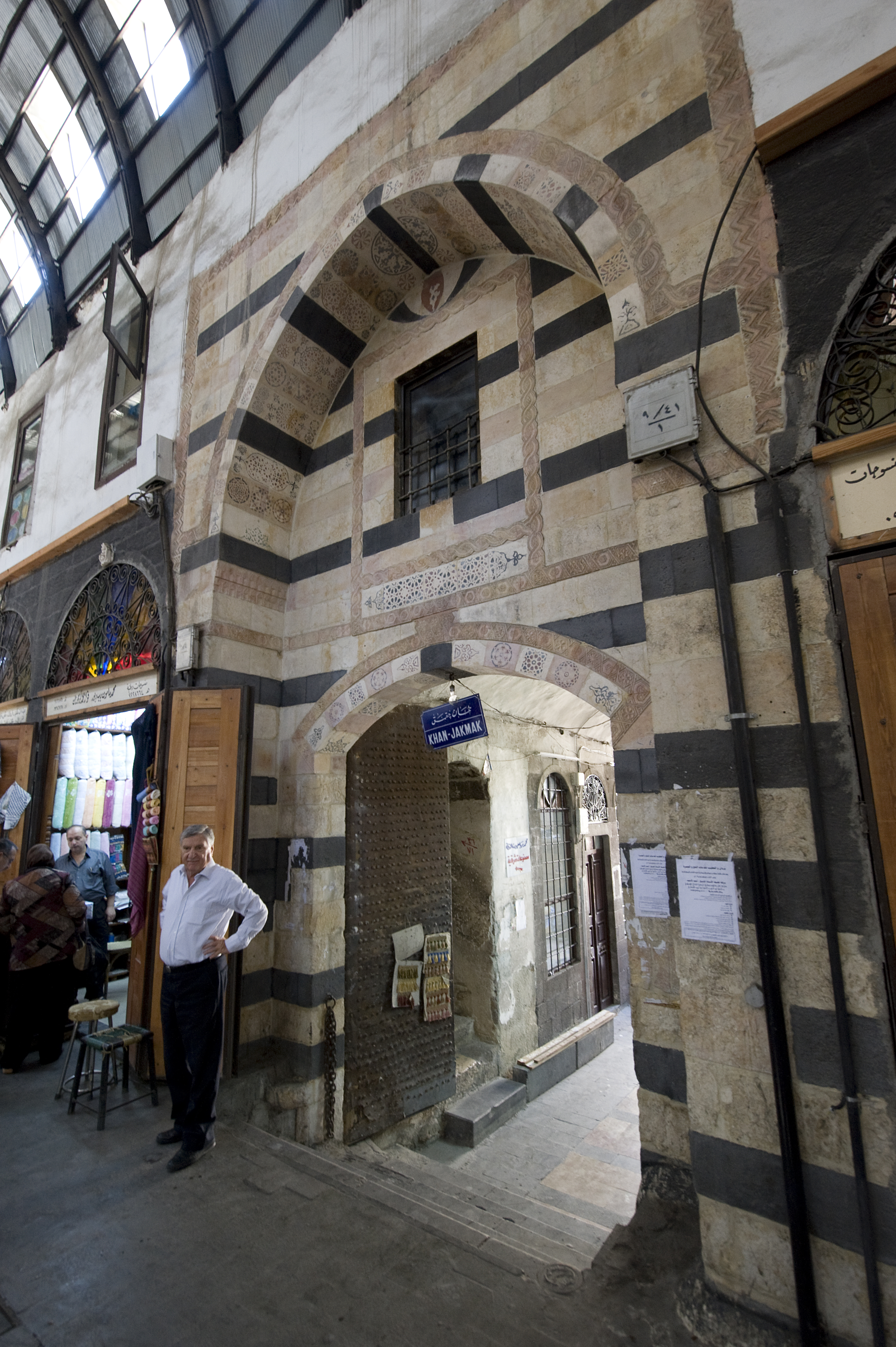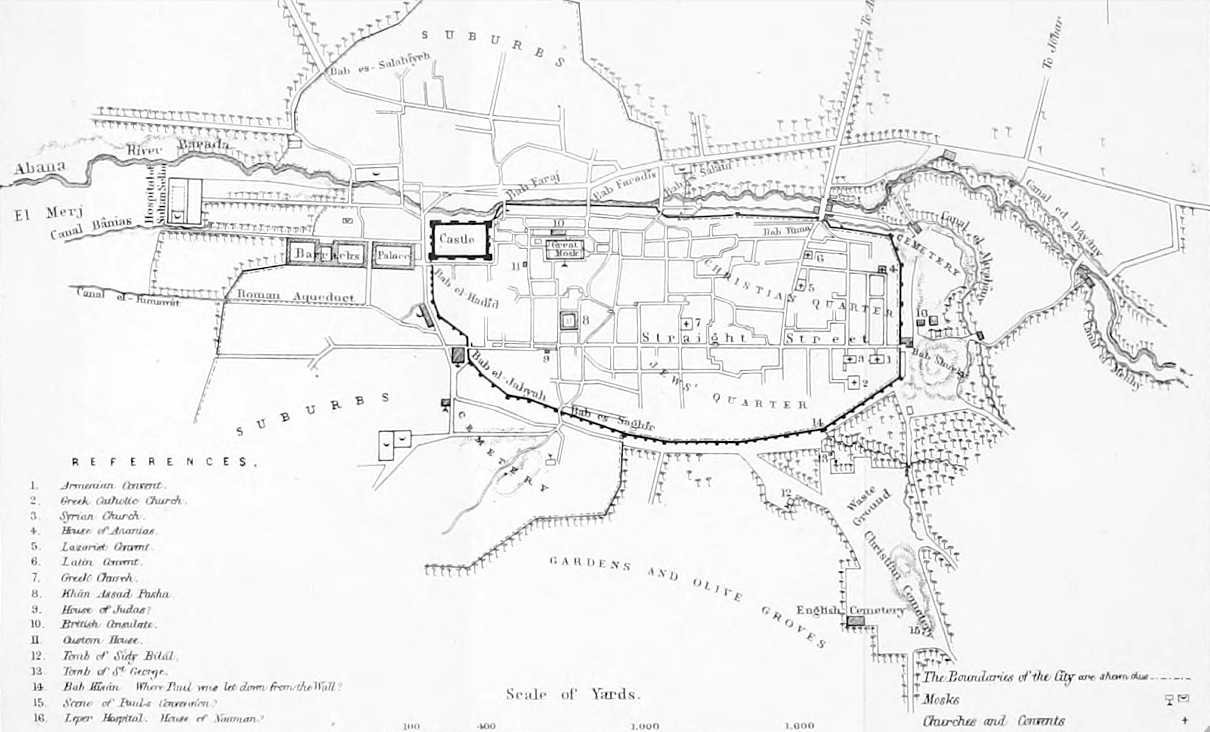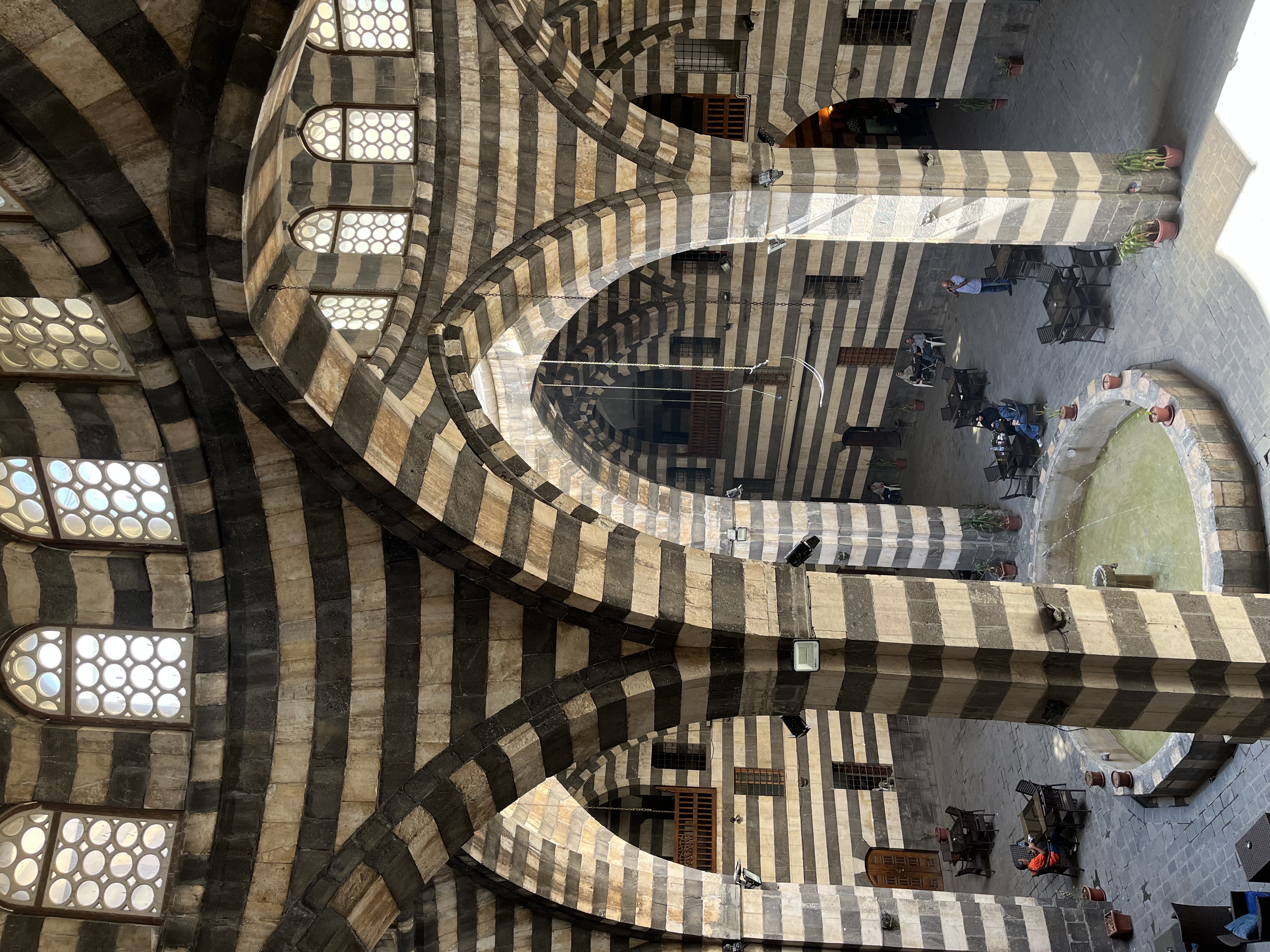|
Khan Jaqmaq
Khan Jaqmaq ( ar, خَان جَقْمَق, Ḵān Jaqmaq) is one of the few remaining caravansary, khans in the Old City of Damascus, it was built by the Mamluk emir, Sayf ad-Din Jaqmaq who was governor of Damascus in 1418–20. It was rebuilt to a great extent in 1601.Jaqmaq Khan Archnet Digital Library. 
See also *Khan As'ad Pasha *Khan Sulayman Pasha *Khan Tuman (building), Khan TumanReferences Buildings and structures completed in 1420 Caravanserais in Damascus 15th-century establishments in the Mamluk Sultanate {{Syria-struct-stub ...[...More Info...] [...Related Items...] OR: [Wikipedia] [Google] [Baidu] |
Caravanserai
A caravanserai (or caravansary; ) was a roadside inn where travelers ( caravaners) could rest and recover from the day's journey. Caravanserais supported the flow of commerce, information and people across the network of trade routes covering Asia, North Africa and Southeast Europe, most notably the Silk Road. Often located along rural roads in the countryside, urban versions of caravanserais were also historically common in cities throughout the Islamic world, and were often called other names such as ''khan'', ''wikala'', or ''funduq''. Terms and etymology Caravanserai Caravanserai ( fa, کاروانسرای, ''kārvānsarāy''), is the Persian compound word variant combining ''kārvān'' "caravan" with ''-sarāy'' "palace", "building with enclosed courts". Here "caravan" means a group of traders, pilgrims or other travellers, engaged in long-distance travel. The word is also rendered as ''caravansary'', ''caravansaray'', ''caravanseray'', ''caravansara'', and ''caravans ... [...More Info...] [...Related Items...] OR: [Wikipedia] [Google] [Baidu] |
Mamluk
Mamluk ( ar, مملوك, mamlūk (singular), , ''mamālīk'' (plural), translated as "one who is owned", meaning " slave", also transliterated as ''Mameluke'', ''mamluq'', ''mamluke'', ''mameluk'', ''mameluke'', ''mamaluke'', or ''marmeluke'') is a term most commonly referring to non-Arab, ethnically diverse (mostly Southern Russian, Turkic, Caucasian, Eastern and Southeastern European) slave-soldiers and freed slaves who were assigned military and administrative duties, serving the ruling Arab dynasties in the Muslim world. The most enduring Mamluk realm was the knightly military class in Egypt in the Middle Ages, which developed from the ranks of slave-soldiers. Originally the Mamluks were slaves of Turkic origin from the Eurasian Steppe, but the institution of military slavery spread to include Circassians, Abkhazians, Georgians,"Relations of the Georgian Mamluks of Egypt with Their Homeland in the Last Decades of the Eighteenth Century". Daniel Crecelius and Gotc ... [...More Info...] [...Related Items...] OR: [Wikipedia] [Google] [Baidu] |
Damascus
)), is an adjective which means "spacious". , motto = , image_flag = Flag of Damascus.svg , image_seal = Emblem of Damascus.svg , seal_type = Seal , map_caption = , pushpin_map = Syria#Mediterranean east#Arab world#Asia , pushpin_label_position = right , pushpin_mapsize = , pushpin_map_caption = Location of Damascus within Syria , pushpin_relief = 1 , coordinates = , subdivision_type = Country , subdivision_name = , subdivision_type1 = Governorate , subdivision_name1 = Damascus Governorate, Capital City , government_footnotes = , government_type = , leader_title = Governor , leader_name = Mohammad Tariq Kreishati , parts_type = Municipalities , parts = 16 , established_title = , established_date ... [...More Info...] [...Related Items...] OR: [Wikipedia] [Google] [Baidu] |
Syria
Syria ( ar, سُورِيَا or سُورِيَة, translit=Sūriyā), officially the Syrian Arab Republic ( ar, الجمهورية العربية السورية, al-Jumhūrīyah al-ʻArabīyah as-Sūrīyah), is a Western Asian country located in the Eastern Mediterranean and the Levant. It is a unitary state, unitary republic that consists of Governorates of Syria, 14 governorates (subdivisions), and is bordered by the Mediterranean Sea to the west, Turkey to the north, Iraq to Iraq–Syria border, the east and southeast, Jordan to Jordan–Syria border, the south, and Israel and Lebanon to Lebanon–Syria border, the southwest. Cyprus lies to the west across the Mediterranean Sea. A country of fertile plains, high mountains, and deserts, Syria is home to demographics of Syria, diverse ethnic and religious groups, including the majority Syrians, Syrian Arabs, Kurds in Syria, Kurds, Syrian Turkmen, Turkmens, Assyrians in Syria, Assyrians, Armenians in Syria, Armenians, Circa ... [...More Info...] [...Related Items...] OR: [Wikipedia] [Google] [Baidu] |
Street Called Straight
Straight Street, from the Latin Via Recta ( ar, الشارع المستقيم ''al-Shāriʿ al-Mustaqīm''), known as the Street called Straight ( gr, τήν ῥύμην τήν καλουμένην εὐθείαν) in the New Testament, is the old '' decumanus maximus'', the main Roman road, of Damascus, Syria. It runs from east to west through the old city. According to the Acts of the Apostles (9:11), Paul the Apostle stayed in a house on Straight Street. The western half of the street, including the Midhat Pasha Souq, is today also known as "Midhat Pasha Street", while the eastern half, leading to the Bab Sharqi gate, is known as "Bab Sharqi Street". History According to the King James Version The King James Version (KJV), also the King James Bible (KJB) and the Authorized Version, is an English translation of the Christian Bible for the Church of England, which was commissioned in 1604 and published in 1611, by sponsorship of K ... of the English bible: :"And the ... [...More Info...] [...Related Items...] OR: [Wikipedia] [Google] [Baidu] |
Sayf Ad-Din Jaqmaq
Sayf ad-Din Jaqmaq ( ar, الظاهر سيف الدين جقمق; 1373 – 13 February 1453) was the Mamluk sultan of Egypt from 9 September 1438 to 1 February 1453. Early life and career Jaqmaq was of Circassian descent. He was brought to Egypt by his older brother and sold to ''atabeg'' Inal Al-Yusufi during the reign of Sultan Barquq. He later trained in the Cairo Citadel to join the ''Khasikiya'' (Sultan's Guards). He then worked as a cupbearer for Sultan An-Nasir Faraj, until he was imprisoned with his brother during a period of instability, to be later freed by emir Taghribirdi, grandfather of Ibn Taghribirdi. Later on, he became the Mamluk na'ib of Damascus during the reign of Al-Mu'ayyad Shaykh in 1418–1420, in which he built Khan Jaqmaq. Then he became ''na'ib'' of the Cairo Citadel under Sultan Sayf ad-Din Tatar. Afterwards, he became ''atabeg'' under Sultan Barsbay, in which he led a campaign to repress the revolt of Beylik of Dulkadir in Anatolia. He earned Bar ... [...More Info...] [...Related Items...] OR: [Wikipedia] [Google] [Baidu] |
Caravansary
A caravanserai (or caravansary; ) was a roadside Pub#Inns, inn where travelers (caravan (travellers), caravaners) could rest and recover from the day's journey. Caravanserais supported the flow of commerce, information and people across the network of trade routes covering Asia, North Africa and Southeast Europe, most notably the Silk Road. Often located along rural roads in the countryside, urban versions of caravanserais were also historically common in cities throughout the Muslim world, Islamic world, and were often called other names such as ''khan'', ''wikala'', or ''funduq''. Terms and etymology Caravanserai Caravanserai ( fa, کاروانسرای, ''kārvānsarāy''), is the Persian compound word variant combining ''kārvān'' "caravan (travellers), caravan" with ''-sarāy'' "palace", "building with enclosed courts". Here "caravan" means a group of traders, pilgrims or other travellers, engaged in long-distance travel. The word is also rendered as ''caravansary'', ''c ... [...More Info...] [...Related Items...] OR: [Wikipedia] [Google] [Baidu] |
Old City Of Damascus
The Ancient City of Damascus ( ar, دِمَشْق ٱلْقَدِيمَة, Dimašq al-Qadīmah) is the historic city centre of Damascus, Syria. The old city which is one of the oldest continuously inhabited cities in the world, contains numerous archaeological sites, including some historical churches and mosques. Many cultures have left their mark, especially Hellenistic, Roman, Byzantine and Islamic. In 1979, the historical center of the city, surrounded by walls of Roman era, was declared a World Heritage Site by UNESCO. In June 2013, UNESCO included all Syrian sites on the list of World Heritage in Danger to warn of the risks to which they are exposed because of the Syrian Civil War. Origins and founding Lying on the south bank of Barada River, the ancient city was founded in the 3rd millennium B.C. The horizontal diameter of the oval is about 1.5 km (0.9 mi) which is known as Damascus Straight Street, while the vertical diameter ( la, Cardus Maximus) is about 1&nb ... [...More Info...] [...Related Items...] OR: [Wikipedia] [Google] [Baidu] |
Damascus Khan Jaqmaq 5399
)), is an adjective which means "spacious". , motto = , image_flag = Flag of Damascus.svg , image_seal = Emblem of Damascus.svg , seal_type = Seal , map_caption = , pushpin_map = Syria#Mediterranean east#Arab world#Asia , pushpin_label_position = right , pushpin_mapsize = , pushpin_map_caption = Location of Damascus within Syria , pushpin_relief = 1 , coordinates = , subdivision_type = Country , subdivision_name = , subdivision_type1 = Governorate , subdivision_name1 = Damascus Governorate, Capital City , government_footnotes = , government_type = , leader_title = Governor , leader_name = Mohammad Tariq Kreishati , parts_type = Municipalities , parts = 16 , established_title = , established_date ... [...More Info...] [...Related Items...] OR: [Wikipedia] [Google] [Baidu] |
Khan As'ad Pasha
Khan As'ad Pasha ( ar, خَان أَسْعَد بَاشَا, Khān ʾAsʿad Bāşā) is the largest caravanserai () in the Old City of Damascus, covering an area of . Situated along Al-Buzuriyah Souq, it was built and named after As'ad Pasha al-Azem, the governor of Damascus, in 1751–52.As'ad Pasha Khan Archnet Digital Library. Khan As'ad Pasha has been described as one of the finest khans of Damascus, and the most "ambitious" work of architecture in the city. Throughout the , it hosted caravans coming from , |
Khan Sulayman Pasha
Khan Sulayman Pasha ( ar, خَان سُلَيْمَان بَاشَا, Khān Sulaymān Bāşā) is a large khan in the Old City of Damascus.Sulayman Pasha Khan Archnet Digital Library. See also * Azm Palace * Khan As'ad Pasha * Khan Jaqmaq *Khan Tuman
Khan Tuman ( ar, خان طومان) is a village in northern Syria, administratively part of the Mount Simeon District of Aleppo Governorate, loca ...
[...More Info...] [...Related Items...] OR: [Wikipedia] [Google] [Baidu] |
Khan Tuman (building)
Massab ( ar, خان طومان) is a large 12th-century khan Khan may refer to: *Khan (inn), from Persian, a caravanserai or resting-place for a travelling caravan *Khan (surname), including a list of people with the name *Khan (title), a royal title for a ruler in Mongol and Turkic languages and used by ... in Syria.Tuman Khan Archnet Digital Library. See also * Khan Jaqmaq * Khan As'ad Pasha * Khan Sulayman Pasha * Khan ...[...More Info...] [...Related Items...] OR: [Wikipedia] [Google] [Baidu] |








